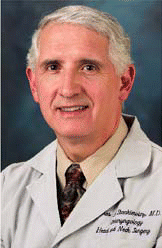ORLANDO, FL-The modified Lothrop procedure is becoming the standard method for treating severe frontal sinus disease, but the osteoplastic frontal sinusotomy still has a role. Patients who qualify for having these operations performed are few, and less aggressive endoscopic frontal procedures should be tried first. Indeed, because of the complicated anatomy and risks involved, only specially trained surgeons should even perform them.
Explore This Issue
July 2008These were the key cautions about the two procedures described at a recent Controversies in Rhinology session hosted by the American Rhinologic Society at the annual Combined Otolaryngology Spring Meeting. To set the stage, Donald Leopold, MD, Chairman of Otolaryngology-Head and Neck Surgery at the University of Nebraska, described some of the historical problems with trying to treat frontal sinus symptoms (FSS).
In fact, how best to treat frontal symptoms is a historical question that has been dealt with by otolaryngologists for more than 100 years, he said. He pointed out that throughout most of the 20th century, there’s been this seesaw back and forth between internal and external procedures. Neither is ideal.
The osteoplastic flap approach to the frontal sinuses was popular in the latter part of the 20th century. It was a big operation… and people typically had numb foreheads afterward, he said. Patients would come back months to years later with fever and pain, often with a cold.
How do you evaluate these folks? This has been the biggest stumbling block for me. Do these patients have an infection? Or do they simply have a migraine headache? he said.
Endoscopy and computer-aided surgical navigation devices have revolutionized how most FSS patients are treated, he said. Obviously, the rules are important in this game. You have to preserve mucosa. You need to be able to see to operate. If you can’t see the tip of your instrument, you shouldn’t be there. You need to learn techniques to control bleeding, Dr. Leopold said.
However, once in a while (rarely, in fact) there are cases in which pathology will not allow for good access through the nose. In these situations, a hybrid approach using both endoscopic and external techniques can be useful.
Use all planes of the CT to really know the anatomy. Depending on the case, a Draf I or a Draf II opening into the frontal sinus can be helpful. The agger nasi cell is the key to this…. And be very careful to find this cell anatomically as you do this operation. Understand the anatomy very, very clearly, Dr. Leopold said.
The Modified Lothrop Procedure
If ipsilateral procedures fail, then the modified Lothrop can be an effective alternative. But few otolaryngologists are trained to do this procedure, and because of the sensitive surrounding anatomy it is a risky approach, he said.


Leave a Reply